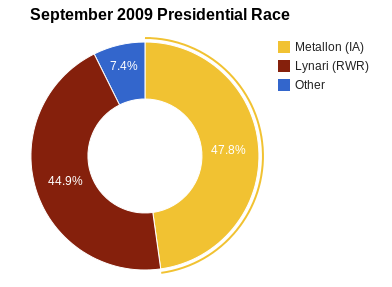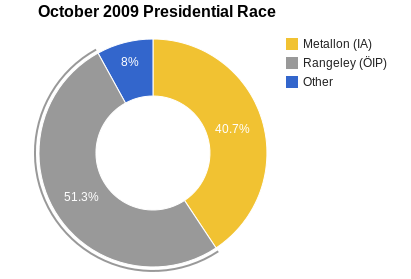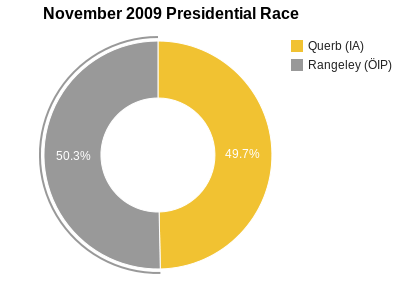[MoE] Political History: The Competitive Era (I)
 •
by
•
by BundesPresseDienst

This is a continuation of a series of articles detailing the political history of eAustria, with this entry beginning in September 2009. This article details the first part of what we are calling the “competitive era” - a time frame with many political battles and swings of influence, as Austria - now in a period of stability - would decide what would come next...
Previous entries:
The One Party Era (April 2009 - August 2009)

The Competitive Era (September 2009 - February 2010)
Presidents: Metallon - Rangeley - Rangeley - Rangeley - Alfred Ball - Borojevic von Bonjar
Defining political battles: IA vs RWR, ÖIP vs IA, ÖIP vs NFA
Defining Issue: Foreign Policy; What type of nation did we want to be?
Defining traits: Big changes in influence - ultimately a strengthened cabinet.
The divisions that began to show in the previous era finally came to head. With Austria in a more stable condition - now having every region returned - the question became, what should be done with this new stability and strength? What type of nation did Austria want to be? This era saw attempts to answer this question - and by the end of it, the nation had found an answer.

Assertive IA
Previously supportive of the Rot Weiss Rot (RWR), the Illuminus Austria (IA) found its moment. Having grown significantly in the last few months, especially from international players who moved to Austria, it broke with the RWR, pushing for an expansionist foreign policy, and a more active role in the broader world war. There was a plan to attract PEACE GC “tanks” - powerful soldiers - to move to Austria, along with influential members of the alliance. Dischmcds was among these players to join - a multi-term president in the eUK and eMexico. Along with strengthening the Austrian army and Austria’s influence in PEACE GC, these new players helped solidify the IA’s position in Austrian politics.
They also found a huge boost when Metallon - the original founder of the RWR - moved to the IA and agreed to run for president under their banner. But President Lynari, fresh off the success of seeing all regions returned, and still personally very popular, was not ready to step aside. He entered the race for what would be an unprecedented fourth consecutive term. He found support from the liberal Osterreich Independence Party (ÖIP), which had grown since its founding. As it favored a peaceful, defensive foreign policy - and was opposed to mass immigration - the RWR was a natural ally against the IA, even if the RWR was not wholly signed onto their same agenda.
In the first contest (September 2009) pitting the two key figures of the previous era against each other, Metallon came out ahead - delivering a win to the newly dominant IA - over Lynari and the RWR (47.79% to 44.85
😵.

Changes in September
September would see several changes in Austria, including a significant turnover in the cabinet, with many longtime RWR members being replaced by the IA. This set the stage for one of the most contentious months politically in Austria, as many people who had been pushed into the unfamiliar position of being outside the government - essentially being “out of work.” While the RWR had previously been known as a conciliatory party when it held the presidency, it quickly assumed the role of critical opposition. Arguments frequently turned bitter, and the media saw many articles from both members of the IA and RWR facing off, including through government papers.
Militarily, Austria had been involved in operations abroad in previous months, but in September this greatly increased. It saw the first “common hit times” take place, particularly with a deployment into Canada to aid an allied invasion force. To go with this was a significant increase in funding to the alliance’s effort. 200 gold was designated for the alliance - far more than most nations would give, even though Austria was still among the smallest nations. This donation would become controversial amongst some Austrians, and was another issue of contention.
Minister of Finance Olorum led the ministry in a policy of issuing more currency, in order to lower the overall value of the ATS (during this time, there was not a universal currency - each nation had their own). This was done with the plan to make Austria more competitive in the export market, but came under criticism particularly from the ÖIP, which favored keeping the ATS value stable.

Rising ÖIP
As with the IA, the ÖIP saw growth during August. But September would present a new opportunity. Increasingly, the feuding between the IA and RWR became perceived as personal. Even though the ÖIP had far greater differences with the IA than the RWR did - and the ÖIP certainly participated in criticisms - it stuck strictly to policy and politics under Travis James’ leadership. This significantly raised its profile and earned new members who grew tired of the other parties.
As well, the central push of the party - a defensive, peaceful foreign policy - grew increasingly popular by Austrians, wary of too much involvement (both military and monetary) in the world war, and to the impacts of being an “international state.” Missteps by the IA - by far the most vocal proponent of expansion - increased this further.
As September wound down, Metallon sought re-election in October for a fourth overall term, with a planned invasion of the Czech Republic as a top agenda item. Lynari considered running again under the RWR, but declined. During Metallon’s term, the RWR begun a decline from which it would not recover, as members headed for other parties. Though it was once the largest party, it now fell behind the IA.
Seeking a candidate to challenge Metallon, instead they turned to the ÖIP - now ranked 3rd overall - who put forward Rangeley, a congress member, as their candidate in October. While the Socialist Party had not supported either candidate in September, the ÖIP openly sought them as a political ally, and would find common ground with Party President Arthur Reynolds on issues of foreign policy. On this issue as well, they would find common ground with the newly formed nationalist party, the National Front of Austria, led by Alfred Ball.
The October presidential race saw IA’s Metallon against the ÖIP’s Rangeley - with the backing of the RWR, SP, and NFA. This race would see yet another turnover of power: the ÖIP came out on top (51.33% to 40.67
😵.

Changing Course
The new ÖIP government understood it was in a tenuous position - winning only with the backing of a broad, potentially shaky coalition. It would take a delicate balancing act to not only enact changes, but also see them upheld in future elections. While Metallon had approached the presidency as a commander, Rangeley approached it more politically. Prominent members of the previous months cabinet were given a chance to continue in their roles. Although some declined, ultimately the cabinet would include members from all major parties, including IA member Dishmcds as Minister of Finance. And the cabinet was directed to avoid media-warring, with the president instead directly addressing complaints in regular updates.
The first Constitution of Austria - which had been drafted during the previous month - was signed into law, an initiative that had backing from all parties. But on foreign policy, change would be swift: the first military order given was to withdraw from all offensive operations, sticking strictly to defensive battles. Likewise, the plan to invade the Czech Republic was scrapped entirely; instead, a deal promising mutual respect and sovereignty between Austria and the Czech Republic was brokered. This would receive criticism from the IA, which still aimed its sights towards expansion.
On economic policy, there would be softer shifts. Government programs aiding new players, which had expanded greatly over the past few months, remained the centerpiece of the Socialist Party’s agenda - a key backer of the ÖIP-led government. These were expanded, yet at the same time, their funding method was changed from tax money, to being entirely donation based, favored by the liberal ÖIP. With less money being spent on military operations as well, the focus was placed on stockpiling after the heavy spending of September - and away from manipulating the monetary market. Instead, Minister of Finance Dishmcds worked to stabilize the exchange rates.
Although tensions had cooled from the heights of the previous month, there still remained vast disagreements about which course to take - and the more vocal members of the IA were very critical of the ÖIP-led government and its policies. Meanwhile, the IA continued to grow, in part due to the continued decline of the RWR, and in part due to continued immigration. By this point in time, citizenship had been introduced, and the IA held more citizenship approvals than other parties due to their strong representation in congress.
The November race saw the IA again challenge the ÖIP and it’s supporting coalition of the RWR, SP, and NFA. Though there was speculation that Metallon might mount a bid to retake the presidency, he would decline - as would Dishmcds. Instead, Querb, a military commander within PEACE GC, represented the party. What would follow was one of the closest elections in Austrian history. By a single vote, the ÖIP came out on top (50.33% to 49.67
😵.

A Decisive Election
This would prove significant - after two months of radical turnover, November re-affirmed - if by the narrowest of margins - the ÖIP’s policies. It would be a turning point for the IA, as it began to lose members. The surprising collapse of the PEACE GC alliance a few days later also removed one of the central concepts of the IA, and after this double-blow many of its members would leave for other nations. The remaining members of the IA would begin a reform under its new leader, the more liberal Oraizan, that saw it abandon its focus on expansion - while still emphasizing the importance of experience and cooperation with allies.
The collapse of PEACE GC would affect the National Front of Austria as well. Since its founding as a party in September, the NFA had grown greatly: taking a nationalistic line, it favored total withdrawal from PEACE GC. This increasingly began to cause problems with the ÖIP-led government - tensions which seemed destined to come to head until the alliance collapsed in mid-November. With this surprising turn, foreign policy became an area where all major parties essentially agreed to the status quo: remaining outside of an alliance officially, with close cooperation with allied nations.

But as one issue is settled, more always arise. With foreign policy off the table, the old coalitions would disband - parties would now fight in this new environment for the political future of the country.

Next: The Competitive Era (Part II)


Comments
still no Schwrzwolf around, this time must have sucked
no luis grindl either
Borojevic von bonjar, i remember him 🙂
[removed]
v+
mentioned in
International Press Review Vol 1
www.erepublik.com/de/article/2496442/1/2
v
Great Article.
I understand some things better now....
Thank you!!
Heh...I was an eBaby at that time 😃
and now you are almost a eGrandpa?
😃
Get off my eLawn!
I think I must have been asleep through all this...
Bundeskanzler Rangeley von Tentacle Monster Porn
o7
great one 😃
btw you forgot the PTO in time of Hedera and so on 😃 ( I know since I was kinda part of it xD)
Don't worry, it has not been forgotten 😛 That will be covered in a future entry.
good that you still remember so much of it 😃 good job
[removed]
[removed]
"What would follow was one of the closest elections in Austrian history. By a single vote, the ÖIP came out on top (50.33% to 49.67😵."
My Vote.
: ]
I was a IA Member, but voted for Rangeley (because Querb only wanted to steal Austria and leave the Country).